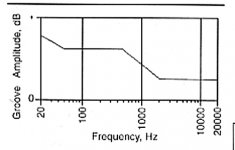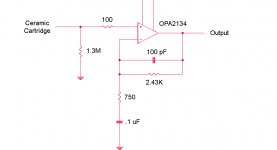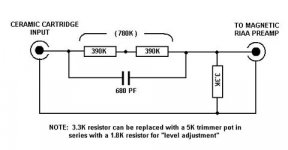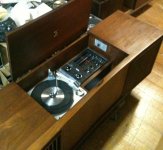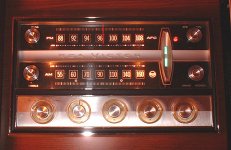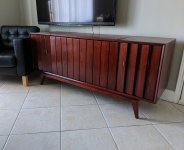Your TL072 thumbnail in post 14 is just what I was thinking of, anyway.
Dunno about the other wiser-than-me fellers, though.
Thanks for posting the whole schematic.
Cheers
Dunno about the other wiser-than-me fellers, though.
Thanks for posting the whole schematic.
Cheers
Ceramic cartridges typically looked like 2-3 nF capacitors electrically speaking, so the load R can be used to tune the bass response. If you can determine the exact C of your cartridge the 1.3M R can be selected for the 50 Hz break point at the low end of the graph. The cartridge itself is a constant amplitude device and exhibits an output shown in the graph to an RIAA mastered record. In the pictured op-amp circuit the 318 & 75 uS time constants are achieved in the RC feedback network of the op-amp.
Attachments
Ceramic cartridges typically looked like 2-3 nF capacitors electrically speaking, so the load R can be used to tune the bass response. If you can determine the exact C of your cartridge the 1.3M R can be selected for the 50 Hz break point at the low end of the graph. The cartridge itself is a constant amplitude device and exhibits an output shown in the graph to an RIAA mastered record. In the pictured op-amp circuit the 318 & 75 uS time constants are achieved in the RC feedback network of the op-amp.
Short of measuring it, I'm not sure how I would go about figuring out the capacitance. And I have nothing that can reliably measure such tiny capacitances.
I've tried researching the cartridge, but the only information Zenith seems to have published is the tracking weight and output voltage.
I suppose I could also try this method through trial and error. Thank you for another option!
wiseoldtech said:You'll get a ton of opinions about things like this.
When I read such things, I merely correct them, and usually get a bunch of flack.
I try to avoid correcting anyone, since in my case, I barely know what I'm talking about. Haha!
I would love to see the simple fix you mentioned earlier, if you have it handy.
Knarfor, this simple circuit can be put together and used to adapt the ceramic cartridge for use into the RIAA "phono" input of "modern" receivers and integrated amps.
It works quite well.
Try it, you'll like it.
Thanks for this. I think it might be worth buying an LP with a frequency sweep, and seeing if I can tune this circuit so my table gives a flat output.
Thanks for this. I think it might be worth buying an LP with a frequency sweep, and seeing if I can tune this circuit so my table gives a flat output.
Unless I'm mistaken....
This is a 1960's console stereo with a belt drive Zenith-designed changer, right?
And the ceramic cartridge involved is the stock "floating style" one?
If so, you're way over-thinking this situation.
It's not a super-duper high-end audiophile stereo system.
I'm sure you want it to sound nice, but why get so involved over-doing something that borders on obsessive.
The simple circuit that I provided is ample enough to give the cartridge output fine tonal quality without all the fussing around.
The optional level/pot may be useful to match the volume of the tuner output if a receiver is used.
Over the years, I've modified quite a few consoles of that era for customers, paying good money for total restorations, including custom work.
And none of them were dis-satisfied, in fact, their jaws dropped when their units were demonstrated in my shop lobby.
One of the last consoles I worked on was a top-of-the-line RCA Victor 6 foot wide model that originally sold for $550 in 1966.
Asides from using test equipment to re-align the tuner after repairing it, I didn't need test records or the like to tweak the record changer.
My experience with these things is enough.
Attachments
...you're way over-thinking this situation...
Haha! Indeed. But that's the fun!!! Seriously, though. I'm involved in this hobby to learn and explore. It's all about the journey the work takes me on. The more work, the more learning, the more fun.
You'd probably be shocked at all the trouble I'm going through in another thread knit-picking a relay control circuit. But I've learned *tons* from it. It's all very exciting.
Last edited:
Haha! Indeed. But that's the fun!!! Seriously, though. I'm involved in this hobby to learn and explore. It's all about the journey the work takes me on. The more work, the more learning, the more fun.
You'd probably be shocked at all the trouble I'm going through in another thread knit-picking a relay control circuit. But I've learned *tons* from it. It's all very exciting.
In this case, there's no "nit picking" needed or required for the simple circuit I provided.
I've done that already, using decades of experience working in the shop.
I like to keep things simple, reliable, and effective.
In this case, there's no "nit picking" needed or required for the simple circuit I provided.
I've done that already, using decades of experience working in the shop.
I like to keep things simple, reliable, and effective.
I'd love to nit-pick the autocorrect on my phone. No idea what a "knit-pick is." It also likes to "autocorrect" to the wrong usage of it's and its.
But in any case, I think I have the parts for your adapter circuit. I'll whip it together and see how it works out! Thanks again.
When modifying that Zenith console, as with other brands of consoles, one must consider several and inter-related things.
It's been stated that the original amp/electronics will be replaced by something of "modern design".
All well and fine, but Zenith designed the unit with a particular "voicing" in mind - the amp, speakers, even the controls, were mated together for a particular sonic signature and performance level.
Even the cabinet/speaker chambers were part of the manufacturer's equasions for the sound that they ultimately produce.
Changing ANYthing in that audio chain will of course change the resulting sound.
If another amp is used, the speakers themselves must be dealt with - they usually only can handle a couple of watts, maybe 5 to 15W roughly.
It doesn't matter what the sales literature states, those advertised "240 watts of peak power" were justified as a sales-getter, while the actual RMS values were more like maybe 10W.
So using a say, 45W/channel modern amp will kill off those original speakers quickly.
I've re-done plenty of consoles, and trust me, it's an involved process to "get it right".
Most times, the original receivers are much better "tuned to the system", and should be retained.
Plus, they had style that fit the era they were made in.
My own 1963 tube RCA Victor console control panel - much more sexy than something modern...
It's been stated that the original amp/electronics will be replaced by something of "modern design".
All well and fine, but Zenith designed the unit with a particular "voicing" in mind - the amp, speakers, even the controls, were mated together for a particular sonic signature and performance level.
Even the cabinet/speaker chambers were part of the manufacturer's equasions for the sound that they ultimately produce.
Changing ANYthing in that audio chain will of course change the resulting sound.
If another amp is used, the speakers themselves must be dealt with - they usually only can handle a couple of watts, maybe 5 to 15W roughly.
It doesn't matter what the sales literature states, those advertised "240 watts of peak power" were justified as a sales-getter, while the actual RMS values were more like maybe 10W.
So using a say, 45W/channel modern amp will kill off those original speakers quickly.
I've re-done plenty of consoles, and trust me, it's an involved process to "get it right".
Most times, the original receivers are much better "tuned to the system", and should be retained.
Plus, they had style that fit the era they were made in.
My own 1963 tube RCA Victor console control panel - much more sexy than something modern...
Attachments
...
I've re-done plenty of consoles, and trust me, it's an involved process to "get it right".
Most times, the original receivers are much better "tuned to the system", and should be retained.
Plus, they had style that fit the era they were made in.
My own 1963 tube RCA Victor console control panel - much more sexy than something modern...
That's gorgeous! I think a lot of people my age (I'm in my early 30's) don't fully appreciate the sexiness (and that's exactly what it is) of designs like that. Minimal mid-century is in vogue more than anything else. But I love the lines and light of the more audacious designs of that era.
My console was found on the side of the road. It had been stored in a shed/garage here in Florida for several decades, where from the looks of it, it became quite the successful settlement for roaches.
The preamp/tuner is missing most of the buttons and has a lot of cosmetic damage. The amp looks fine except for all the roach droppings. I'm going to sell both so that consoles in better condition might live.
The speakers were in fine shape (surprisingly), and have already been sold to finance the restoration of the rest of the unit. Lesser known drivers like the woofers in this unit don't often sell for much on eBay, but they do when you can provide measurements and proof of their performance, as I did. So I made quite a bit.
The turntable survived in like-new condition because the owner had, apparently, removed and kept it indoors before storing the console in his shed. The table was sitting in a box next to the console looking as-pictured below.
I have thoroughly cleaned and completely refinished the cabinet, which came out gorgeous. Now I'm building it out with an eye to the future. I'm keeping the original turntable, then installing a wireless/Bluetooth receiver, as well as auxiliary inputs. No tuner. The internet is the new radio. The new amp/preamp will not take up the space of the originals, so I will probably install a pop-up bar and larger record storage space where they once were. I know some might frown at this, but this entire unit would otherwise be in the dump right now.
And I fully take your point about viewing this/designing it as a system. I can't claim the competence of Zenith or you and others here; but I'll take my time, do my research, measure, and ask a lot of questions along the way. I will pick speaker drivers along with the amp/pre. But I'm first working to figure out what the turntable will need. Hence this thread.
Wish me luck! I have a lot of simultaneously ongoing projects, so this will take a while, but I'll post the results here as I make progress.
Attachments
That's gorgeous! I think a lot of people my age (I'm in my early 30's) don't fully appreciate the sexiness (and that's exactly what it is) of designs like that. Minimal mid-century is in vogue more than anything else. But I love the lines and light of the more audacious designs of that era.
My console was found on the side of the road. It had been stored in a shed/garage here in Florida for several decades, where from the looks of it, it became quite the successful settlement for roaches.
The preamp/tuner is missing most of the buttons and has a lot of cosmetic damage. The amp looks fine except for all the roach droppings. I'm going to sell both so that consoles in better condition might live.
The speakers were in fine shape (surprisingly), and have already been sold to finance the restoration of the rest of the unit. Lesser known drivers like the woofers in this unit don't often sell for much on eBay, but they do when you can provide measurements and proof of their performance, as I did. So I made quite a bit.
The turntable survived in like-new condition because the owner had, apparently, removed and kept it indoors before storing the console in his shed. The table was sitting in a box next to the console looking as-pictured below.
I have thoroughly cleaned and completely refinished the cabinet, which came out gorgeous. Now I'm building it out with an eye to the future. I'm keeping the original turntable, then installing a wireless/Bluetooth receiver, as well as auxiliary inputs. No tuner. The internet is the new radio. The new amp/preamp will not take up the space of the originals, so I will probably install a pop-up bar and larger record storage space where they once were. I know some might frown at this, but this entire unit would otherwise be in the dump right now.
And I fully take your point about viewing this/designing it as a system. I can't claim the competence of Zenith or you and others here; but I'll take my time, do my research, measure, and ask a lot of questions along the way. I will pick speaker drivers along with the amp/pre. But I'm first working to figure out what the turntable will need. Hence this thread.
Wish me luck! I have a lot of simultaneously ongoing projects, so this will take a while, but I'll post the results here as I make progress.
Regardless of the cosmetic condition of the record changer, it'll now require a full overhaul due to aging.
This record changer was a "special" model made "in-house" by Zenith, and was a dramatic change from their previous designs.
I posted a photo of the earlier version on this thread that I serviced and sold on craigs list last year.
It's belt drive, with an unusal 4 speed drive chain - including an intermediate flywheel, and a two-piece "isolated" platter.
The "popup" 45 RPM adapter is also unique to this model.
You're looking at a rabbit-hole, a can of worms, involved in doing service to this machine.
I hate sounding negative, but that's the reality of it - I know from experience.
There is super critical re-alignments involved during service, and if you're not experienced, you'll be pulling your hair out and cursing.
Zenith did not provide documentation for this type of servicing, only normal service and adjustments, because like any "normal service", age is not factored in.
Should it require a new belt and idler wheel, the size is also critical, but can be found at the "VM" website from Gary Stork.
Overhauling the 45RPM spindle is a chore too, as is the inner LP spindle.
And again, there's super-picky realignments involved if it is to operate properly.
The main platter bearing assembly MUST be in perfect original position to eliminate play and rumble, even a fraction of a millimeter off and it won't be quiet enough for respectable operation.
The motor mounts also need replacing, because now they sag from age, and the speed change shifter assembly must be flushed and relubed - I use Super Lube with PTFE(teflon) for all the mechanical lubing, including the main platter bearings and its shaft.
The outer platter is also suspended/isolated from the belt driven lower platter by three rubber grommets for noise reduction - I use suitably-sized silicone grommets made for CD mechanism suspension, for improved performance.
Zoom Spout Turbine Oil for motor bearings, flywheel bearings, and tonearm assembly - the vertical pivots are hardened knife-edge bearings - cleaning and light oil is all they'd need.
That tonearm tracks at 3 to 3.5 grams, but flawlessly when serviced.
By the way, in servicing the tonearm horizontal bearings, there's also a critical alignment of the parts there - if not done PERFECTLY, the slip clutch and tonearm lift, along with the size selection dropping with NOT work properly.
There's also a hidden stylus cleaning brush that lurks inside the tonearm rest post - and it pops up during the change cycle to gently wipe the needle on each cycle.
I'm not sure if they changed the main cycle lever on the newer model, my older version required a careful re-designing of the "hump" area with a dremel, then polished smooth in order to improve operation.
Like I said, it's a can of worms, good luck.
The one I sold turned out playing as nice as a Dual turntable - just as quiet, with dead-on speed accuracy.
Last edited:
Your account is closed, but I was able to find this wonderful circuit and wanted to thank you for it. I tried this for the CZ800 clone cartridge, and stunned to experience how rich it sounds from low to the highs. Tried numerous circuit examples which claims to be a velocitizer, found to be designed for respective ceramic cartridges, obviously had shortcomings more or less for the clone, but this one sounds perfect for one that is so cheap, especially around the mid range frequencies.Knarfor, this simple circuit can be put together and used to adapt the ceramic cartridge for use into the RIAA "phono" input of "modern" receivers and integrated amps.
It works quite well.
Try it, you'll like it.
- Home
- Source & Line
- Analogue Source
- High Impedance Input for a Vintage Turntable
